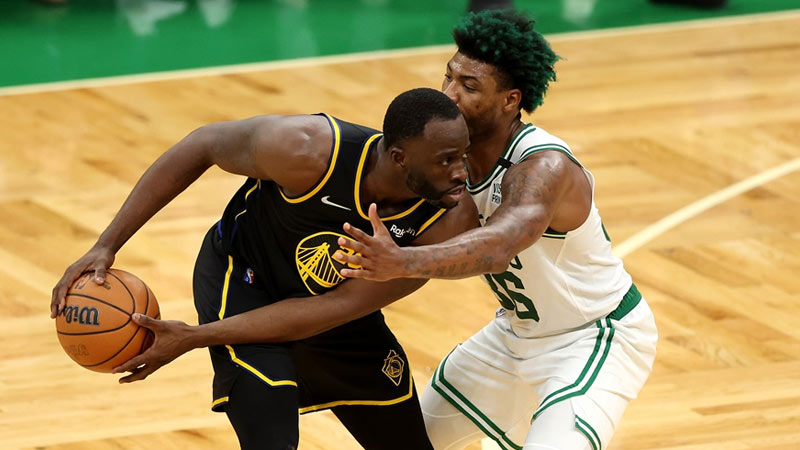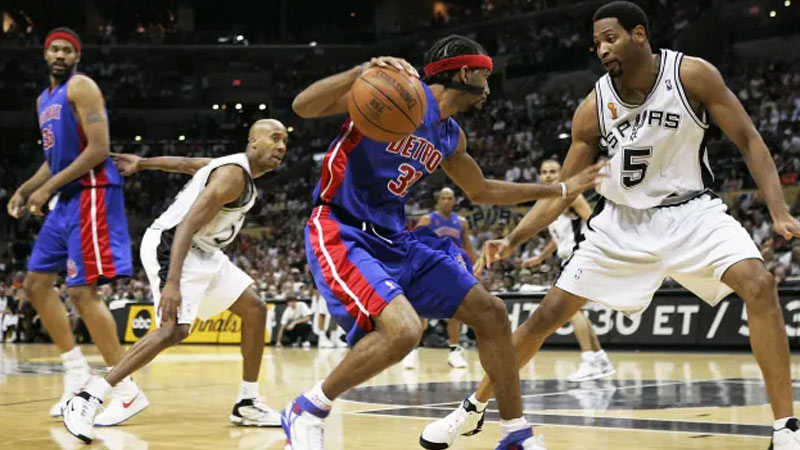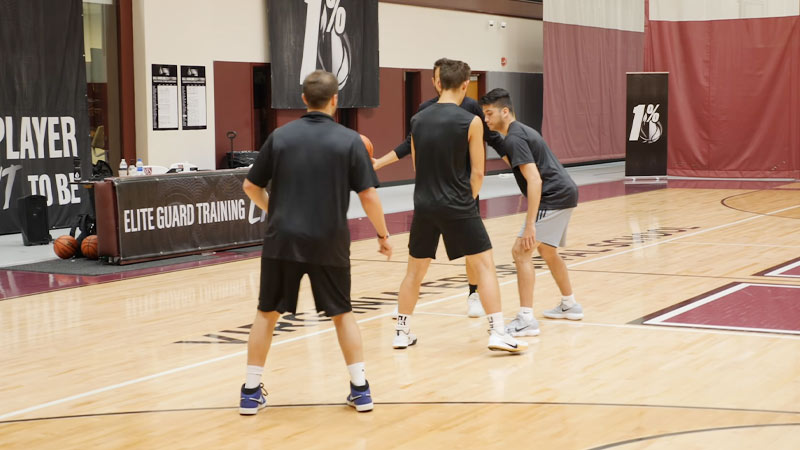In the dynamic sport of basketball, strategic plays and player movements are essential for success on the court. One such tactical maneuver frequently employed by teams is the “pick and pop.”
If you’ve ever wondered what a pick and pop is and how it influences the game, you’ve come to the right place. In this comprehensive guide, we’ll explore the concept of pick and pop in basketball, its execution, and its impact on offensive strategies.
Get ready to uncover the secrets behind this effective play and its role in shaping the outcome of basketball games. So, stay focused.
What Is a Pick-and-Pop in Basketball?
A pick-and-pop is a strategic offensive play in basketball that involves two players working together to create scoring opportunities.
It is a variation of the pick-and-roll, where one player sets a screen (pick) for the ball handler, but instead of rolling to the basket, the screener “pops” back to the perimeter to receive a pass and take a jump shot.
In the pick-and-pop, the ball handler uses the screen set by the big man to create separation from their defender. The screener then quickly moves away from the basket, creating space and forcing the defense to make a decision.
If the defense collapses on the ball handler, the popping player becomes open for a shot. On the other hand, if the defense focuses on the popping player, the ball handler can drive to the basket or find an open teammate for an easy shot.
Why Pick-and-Pop Is a Unique Strategy in Basketball?

Source: eurohoops.net
The pick-and-pop is a unique strategy in basketball due to several reasons:
Utilizes Shooting Big Men
Traditionally, big men in basketball are known for their inside scoring and rebounding abilities. The pick-and-pop allows these players to showcase their shooting skills and become versatile offensive threats.
This adds an extra dimension to the team’s offense and creates matchup problems for the opposing defense.
Spacing and Floor Balance
The pick-and-pop play creates excellent floor spacing, as the popping player moves away from the basket to the perimeter. This forces the defense to stretch out and cover more ground, leaving gaps in the defense that can be exploited by the offense.
Decision-Making Dilemma
The pick-and-pop puts the defense in a difficult decision-making situation. Defenders must choose whether to stick with the ball handler or rotate to cover the popping player. This split-second decision can lead to defensive breakdowns, allowing the offense to capitalize on open shots.
Countering Defensive Strategies
Defenses often have specific strategies to defend against pick-and-roll plays. However, pick-and-pop presents a unique challenge, as the popping player’s shooting ability requires a different defensive approach.
This can catch defenses off guard and lead to open shot opportunities for the popping player.
Two-player Coordination
The pick-and-pop requires excellent coordination and chemistry between the ball handler and the popping player. Both players must read the defense, make quick decisions, and execute the play seamlessly.
Teams with strong pick-and-pop duos can exploit defensive weaknesses and consistently generate scoring opportunities.
How to Execute a Pick-and-pop in Basketball?

Source: bleacherreport.com
Executing a pick-and-pop in basketball requires coordination, timing, and understanding between the ball handler and the popping player. Here’s a step-by-step guide on how to effectively execute a pick-and-pop play:
Communication and Recognition
Before the play begins, the ball handler and the popping player must communicate and recognize the defensive set-up. Identify potential mismatches and defensive weaknesses that can be exploited with the pick-and-pop.
Set the Pick
The big man (popping player) positions themselves near the top of the key or the three-point line. The ball handler (typically a guard) initiates the play by dribbling towards the defender guarding the big man.
As the ball handler approaches, the popping player sets a solid screen (pick) on the defender.
Proper Positioning
As the popping player sets the screen, they must ensure that their feet are shoulder-width apart and their body is square to the defender. This provides a legal screen and prevents offensive fouls.
Create Separation
After setting the pick, the popping player quickly moves away from the basket towards the perimeter. This movement creates separation from the defender and positions the popping player for an open-shot opportunity.
Read the Defense
Both the ball handler and the popping player must read the defense’s reaction to the pick. If the defender guarding the ball handler goes under or gets caught on the screen, the ball handler can use the separation to take a jump shot. If the defender goes over the screen, the ball handler can drive to the basket.
Decision-making
If the defense focuses on the ball handler, the popping player becomes open for a jump shot. The ball handler should make a quick decision and pass the ball to the popping player for the shot.
Shooting Mechanics
The popping player must be ready to catch the pass and quickly go into their shooting motion. Good shooting mechanics are crucial to ensure a high-percentage shot. If the defender closes out quickly, the popping player can use a pump fake to create additional space for the shot.
Follow-through and Rebound
After taking the shot, the popping player should follow through with their shooting motion. If the shot is missed, both the ball handler and the popping player should be prepared for the possibility of an offensive rebound, as the defense may be in a compromising position after the pick-and-pop.
Floor Spacing
The rest of the offensive players should be properly spaced on the court to provide additional options for the ball handler and prevent the defense from collapsing on the pick-and-pop action.
Practice and Repetition
Executing the pick-and-pop play effectively requires practice and repetition. Teams should work on the timing, positioning, and decision-making involved in the play during practices and drills.
By mastering the execution of the pick-and-pop, teams can add a dynamic and effective offensive option to their playbook.
Things to Consider While Executing a Pick-and-pop in Basketball
The following aspects are needed to consider carefully while executing a pick-and-pop in basketball.
Timing
Proper timing is crucial in the pick-and-pop play as it determines the effectiveness of the screen and the subsequent actions. The ball handler must approach the screen at the right moment, allowing the popping player enough time to set a solid pick and create separation.
If the timing is off, the defense may easily recover, nullifying the advantage gained from the pick-and-pop.
Defensive Adjustments
A successful pick-and-pop play relies on the ability of the ball handler and the popping player to adapt to defensive adjustments. Defenses may counter the pick-and-pop by switching defenders, where the defending player guarding the ball handler switches onto the popping player.
Alternatively, defenders may hedge on the screen, temporarily trapping the ball handler to disrupt the play. Being prepared to read and react to these defensive adjustments is essential in keeping the pick-and-pop effective.
Communication
Effective communication between the ball handler and the popping player is key to executing the pick-and-pop seamlessly. Verbal cues, such as calling out the play or signaling the screen, help the ball handler anticipate the screen’s timing.
Additionally, non-verbal cues like eye contact or hand signals can be used to communicate during fast-paced moments, ensuring both players are on the same page.
Defensive Rotation
The pick-and-pop can create defensive rotations as defenders may collapse on the ball handler or the popping player.
The ball handler needs to be aware of these rotations and be ready to exploit the defense’s movement by quickly passing to open teammates. This requires good court vision and decision-making under pressure.
Defensive Recovery
After executing the pick-and-pop, the popping player must be prepared for defensive recovery. If the shot is missed, the popping player needs to hustle back on defense promptly to prevent fast break opportunities for the opposing team.
Failure to recover quickly could lead to a numbers disadvantage for the defense, potentially resulting in easy scoring opportunities for the opposition.
Read the Defense
Reading the defense is a crucial skill for both the ball handler and the popping player during the pick-and-pop play. This involves recognizing how the defense is reacting to the screen and making split-second decisions based on the defender’s movements.
If the defense overcommits to one option, such as focusing heavily on the ball handler, the popping player should be ready to take advantage by popping to an open position for a shot.
Challenges in Executing a Pick-and-pop in Basketball
Despite these following challenges, pick-and-pop remains a valuable and effective offensive strategy in basketball.
Defensive Switching
Defenses may employ switching strategies to counter the pick-and-pop, which can disrupt the play’s effectiveness. Switching defenders quickly can limit the popping player’s shooting opportunities and force the ball handler into tougher driving lanes.
Defensive Pressure
Defenders may apply pressure on the ball handler, making it difficult for them to execute the pick-and-pop smoothly. Ball handlers need to remain composed under pressure and make accurate passes or take decisive shots.
Timing and Coordination
Executing a pick-and-pop requires precise timing and coordination between the ball handler and the popping player. Any miscommunication or mistimed movements can lead to turnovers or missed scoring opportunities.
Defensive Awareness
The defense may anticipate the pick-and-pop play based on team tendencies or previous game footage. Overusing the play without variation can make it predictable and easier for the defense to counter.
Popping Player’s Shooting Ability
The success of the pick-and-pop heavily relies on the popping player’s shooting skills. If the popping player is not a consistent shooter, the defense may choose to leave them open and focus on other offensive threats.
Defensive Recovery
After the pick-and-pop action, the popping player needs to recover quickly on defense. If the popping player is unable to get back in time, it can lead to defensive breakdowns and fast break opportunities for the opposing team.
FAQs
What is a pick-and-pop in basketball?
A pick and pop is a common offensive play in basketball where one player sets a screen (pick) for a ball handler, who can then choose to take a shot or “pop” back to an open position on the perimeter for a jump shot.
It is a pick-and-roll variation that involves the screener moving away from the basket to create space for an open shot.
How does a pick-and-pop work?
In a pick and pop, the player setting the screen (the screener) positions themselves in the path of the defender guarding the ball handler.
This creates an obstacle for the defender, allowing the ball handler to maneuver around the screen more easily. After setting the pick, the screener quickly moves away from the basket, often towards the three-point line, to create separation from their defender.
The ball handler can then choose to pass to the popping player for an open jump shot or take the shot themselves if the defense collapses on the ball handler.
What is the most important advantage of a pick-and-pop play?
The most important advantage of a pick-and-pop play in basketball is the scoring threat it creates from the perimeter. In a pick-and-pop play, one player sets a screen (the pick) for another player, who then “pops” out to the three-point line or mid-range area to receive the ball and take a jump shot.
Which players are best suited for the pick and pop?
The pick-and-pop play is best executed by players who excel at shooting from mid-range or beyond the three-point line. Typically, power forwards and centers with shooting skills are ideal candidates for this play. However, guards with accurate outside shooting can also be effective pop options.
How do defenses counter the pick-and-pop play?
Defending against the pick and pop requires communication and coordination. The defending team must switch defenders when the pick is set to prevent the popping player from getting an open shot.
Alternatively, the defending team can hedge or show on the ball handler to disrupt their path, allowing the original defender to recover and contest the shot. Proper defensive rotations and reading the offense’s movements are critical in countering the pick-and-pop play effectively.
Conclusion
The pick and pop is a strategic offensive play that utilizes the skills of shooting big men and guards with outside shooting ability. This tactical maneuver creates space, forces defensive decisions, and challenges opposing defenses.
The pick-and-pop play provides teams with a versatile offensive option to exploit defensive weaknesses and create scoring opportunities. By mastering the intricacies of this play, teams can elevate their offensive efficiency and add another layer of complexity to their gameplay.
So, the next time you watch a basketball game, keep an eye out for the pick and pop-in action, as it’s a powerful tool that can change the course of the game. Best of luck.







